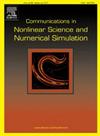基于物理信息的强NESs稀疏识别的一些实际应用
IF 3.4
2区 数学
Q1 MATHEMATICS, APPLIED
Communications in Nonlinear Science and Numerical Simulation
Pub Date : 2025-01-14
DOI:10.1016/j.cnsns.2025.108610
引用次数: 0
摘要
近年来,强非线性能量汇结构得到了广泛的发展,以获得更好的减振性能。采用非线性刚度设计对系统的恢复力测量和参数辨识提出了很大的挑战。近十年来,SINDy(非线性动力学稀疏辨识)方法显著提高了参数辨识的有效性。然而,模型选择、抗噪声能力、同步变量检索等方面的实际考虑,仍然给强非线性结构识别带来挑战。本研究的主要贡献是对强非线性的SINDy识别进行了深入的研究,包括:1)表征强非线性的类型;2)探索积分与微分的数值技术;3)选择合适的自由振动响应和强制振动响应;4)评估抗噪声干扰的鲁棒性;5)考虑其他同样重要的方面。通过对分段线性型、滞后型、软硬化型和三稳型四种典型结构的数值模拟,验证了这些实际问题。研究结果表明,采用数值微分方法,利用强迫振动数据集,并将噪声水平保持在30 dB以下,可以提高识别结果。最后,对强非线性网元结构的稀疏识别进行了讨论,并对提高识别精度和效率的潜在前景进行了总结。本文章由计算机程序翻译,如有差异,请以英文原文为准。
Some practical regards on the application of the physics-informed sparse identification for strongly NESs
Strongly Nonlinear Energy Sink structures (NESs) have been widely developed to achieve better performance of vibration suppression recently. Utilizing nonlinear stiffness designs poses great challenges to the system's restoring force measurement and parameter identification. The SINDy (sparse identification of nonlinear dynamics) method has significantly enhanced the efficacy of parameter identification in the past decade. However, the practical considerations regarding model selection, anti-noise capability, synchronized variable retrieval, etc., still pose challenges in strongly nonlinear structure identification. The primary contribution of this study is to conduct thorough investigations on the SINDy identification of strongly NESs encompassing: 1) characterizing the types of strong nonlinearities; 2) exploring numerical techniques for integration and differentiation; 3) selecting appropriate free and forced vibration responses; 4) assessing robustness against noise interference; and 5) considering other equally important aspects. Numerical simulations are conducted on four typical NES structures including piecewise linear, hysteretic, softening-hardening and tristable types to validate these practical issues. The findings indicate that employing a numerical differentiation approach, utilizing a dataset of forced vibration, and maintaining noise levels below 30 dB can yield enhanced identification outcomes. Finally, some discussions on sparse identification of strongly nonlinear NES structures have been illustrated and potential prospects to improve identification accuracy and efficiency are summarized.
求助全文
通过发布文献求助,成功后即可免费获取论文全文。
去求助
来源期刊

Communications in Nonlinear Science and Numerical Simulation
MATHEMATICS, APPLIED-MATHEMATICS, INTERDISCIPLINARY APPLICATIONS
CiteScore
6.80
自引率
7.70%
发文量
378
审稿时长
78 days
期刊介绍:
The journal publishes original research findings on experimental observation, mathematical modeling, theoretical analysis and numerical simulation, for more accurate description, better prediction or novel application, of nonlinear phenomena in science and engineering. It offers a venue for researchers to make rapid exchange of ideas and techniques in nonlinear science and complexity.
The submission of manuscripts with cross-disciplinary approaches in nonlinear science and complexity is particularly encouraged.
Topics of interest:
Nonlinear differential or delay equations, Lie group analysis and asymptotic methods, Discontinuous systems, Fractals, Fractional calculus and dynamics, Nonlinear effects in quantum mechanics, Nonlinear stochastic processes, Experimental nonlinear science, Time-series and signal analysis, Computational methods and simulations in nonlinear science and engineering, Control of dynamical systems, Synchronization, Lyapunov analysis, High-dimensional chaos and turbulence, Chaos in Hamiltonian systems, Integrable systems and solitons, Collective behavior in many-body systems, Biological physics and networks, Nonlinear mechanical systems, Complex systems and complexity.
No length limitation for contributions is set, but only concisely written manuscripts are published. Brief papers are published on the basis of Rapid Communications. Discussions of previously published papers are welcome.
 求助内容:
求助内容: 应助结果提醒方式:
应助结果提醒方式:


